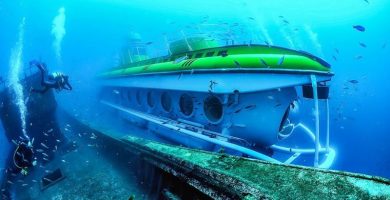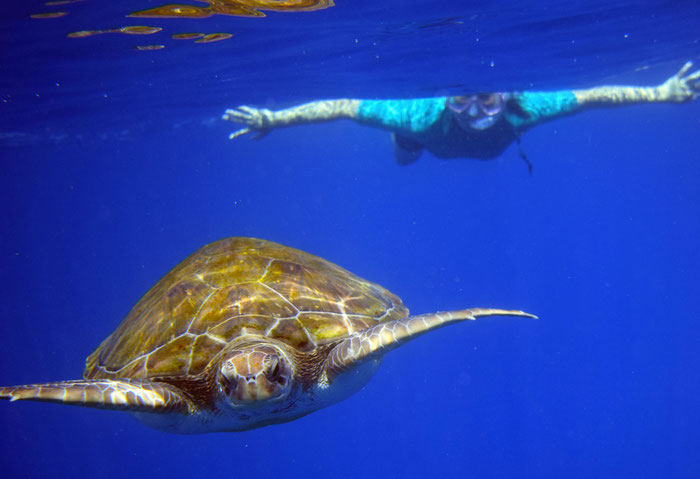
Imagine swimming among turtles and sailing with a kayak surrounded by dolphins. In Tenerife it is possible if you go to the right place.
You can cancel free of charge up to 24 hours before the activity.
This activity is registered with the local tourism authorities, Registro General Turístico with the following code TA-4-0008255.11 and TA-4-0008255.37
Video of the activity
What is included in the price?
- Kayaks
- Paddles
- Waistcoats
- Mask and snorkel
- Neoprene in winter
- Watertight boat for personal belongings
- Photos
Activity information
- The excursions take place all year round
- Duration of the activity: 2.5 hours
- Photographs of the activity are included
- No kayaking experience necessary
- You must be able to swim
- Minimum age: 14 years old
- Weight limit: 180 kg in double kayaks
- It is advisable to take medication against sea sickness if it affects you.
- The activity is not suitable for pregnant women or people with back problems.
- Meeting point: Calle el Coronel, 1, Los Cristianos. The building is called Cristianmar and the office is on the ground floor, next to the building with sea views.
- Languages available: Spanish, English, Portuguese, Italian, French, Italian, Spanish
- Small groups: maximum 15 participants
Where to snorkel with turtles and kayak with dolphins?
The ideal place to snorkel with turtles and kayak with dolphins in Tenerife is Palm-Mar, in Arona, Tenerife South.
Once there, the Arenita Beach is the place where the water excursion begins.
What species of turtles can you see in Tenerife?
In Tenerife you will find mainly two species of sea turtles: the green turtle and the loggerhead turtle or loggerhead turtle.
Discover curiosities and interesting facts about these two species:
Green turtle or Chelonia mydas

- The green turtle is the largest of the hard-shelled turtle species, and is the second largest of all sea turtles.
- Green turtles measure between 91 and 122 cm in length and weigh between 136 and 159 kg.
- Green turtles are believed to live between 60 and 70 years, reaching sexual maturity between the ages of 25 and 35.
- Green turtles are named for their green blubber, which they obtain from their herbivorous diet of sea grasses and algae.
- Green turtles live all over the world and can be found on the coasts of more than 140 countries.
- Normally, only female sea turtles visit shores during their lifetime, but both male and female green turtles have been known to come ashore and bask on Hawaiian beaches.1
- Female green turtles return to the same beach where they hatched to nest, no matter how far away it is.
Loggerhead sea turtle, loggerhead turtle or Caretta caretta
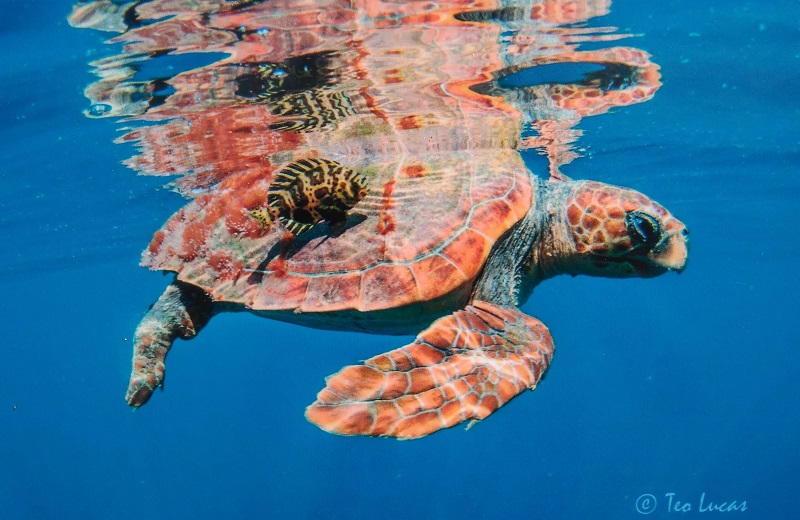
- In Spain we affectionately call it the loggerhead turtle because sometimes when it comes up for air it lies dozing on the surface basking in the sun, so it is easy to catch.
- Caretta caretta is about 0.9 m long and weighs about 113 kg.
- Loggerhead turtles take up to 39 years to reach sexual maturity.
- Loggerhead turtles have a jaw that allows them to feed on hard-shelled prey such as molluscs, whelks and conches.
- Female loggerhead turtles return to the same nesting grounds where they hatched to lay their eggs.
What species of dolphins can you see in Tenerife?

We can find up to 21 species of cetaceans, including dolphins and whales. If we stay with dolphins, there is a species that resides all year round in Tenerife: the bottlenose dolphin (Tursiops truncatus).
Discover curiosities and interesting facts about this species:
- The bottlenose dolphin is the best known species and can be easily spotted when kayaking off the coast of Tenerife.
- Common bottlenose dolphins can grow up to 4 metres long and weigh up to 590 kg. However, males are usually about 2.7 metres long and females about 2.5 metres.
- This species of dolphin lives between 40 and 60 years.
- Female bottlenose dolphins give birth to a calf every 3 to 6 years after a gestation period of 12 months.
- They travel alone or in groups of about 12, but pods of hundreds of dolphins have been seen.
- They swim at less than 12 mph (19 km/h).
- They feed on a wide variety of foods, from fish to squid to shrimp, and consume 6-7 kg of food per day.
- They develop individualised whistles to communicate information about their location, status and identity to others.
Tips for kayaking with dolphins

On this excursion you will enjoy the sensation of being surrounded by pods of dolphins jumping in the air or swimming under the kayak, but don’t worry! They are used to humans and get along well with them, as long as you respect them. Let them flow peacefully, don’t try to touch them and don’t feed them either, just enjoy their presence and they will enjoy yours.
Here are some tips for kayaking with dolphins in Tenerife.
Sit up straight1. Sit up straight
You should sit with your back against the seat and place your heels in the foot guides. The tips of your feet should point outwards and your heels towards the centre of the kayak. As for your knees, they should be slightly bent upwards.
2. Row at a gentle pace
The best thing to do is to save your strength and not burn yourself out at the beginning with strong paddling, starting with a gentle rhythm so that your muscles can gradually adapt to the exercise. After a while you can pick up some more pace, but remember that the goal is to see dolphins and for that it is good to go slowly and enjoy the experience.
3. Do not move away from the group
For everything to go smoothly you must obey the instructions of the professional guide, who knows where the turtles and dolphins are, and who is also responsible for our safety and who knows the sea best. If you move away from the group you run the risk of not following the guide’s instructions and entering an area of currents or a place where you should not go.
4. Move in the direction of the kayak, not in the opposite direction.
Kayaks are very stable when you are on the road, but when you try to make sudden movements in the opposite direction, they can become unstable. To turn with the kayak, you just need to follow the movement and direction with your body and use the kinetic energy of the kayak to your advantage.
Tips for snorkeling with turtles

Sea turtles are species of special protection and are included in the Canary Islands Catalogue of Protected Species (LAW 4/2010, 4th June). That is, they must be respected in the same way as dolphins, without touching or feeding them, just enjoying their presence in the freedom of their habitat.
Here are some tips for snorkeling with turtles in Tenerife:
1. Don’t touch anything
The first and most important rule while snorkeling is not to touch anything, both for your safety and to avoid altering the ecosystem of the marine species that live there (such as turtles).
2. Do not separate yourself from the group
The tour guide will be with you at all times while you enjoy snorkeling with turtles in Tenerife. Stay with the group enjoying the experience and don’t wander away so you don’t risk getting caught in the current.
3. Don’t feed turtles (or other marine wildlife)
During the snorkel you will see, besides turtles, other marine animals such as rays and fish. If you feed them you can seriously alter the natural ecosystem of the area. Giving food to marine animals is also called feeding and is a bad practice that we fight against.
4. Don’t overstep your limits
You can enjoy the underwater world much more if you take your time, go slowly and don’t get tired. Patience is one of the most important qualities you need during snorkeling, take your time to explore and search. If you rush, you will surely scare away the very wildlife you are looking for.
More activities in Tenerife
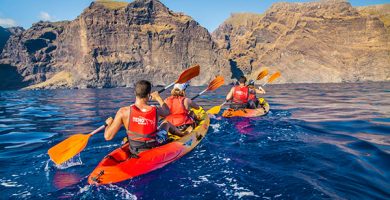
Kayaking in Los Gigantes, Tenerife
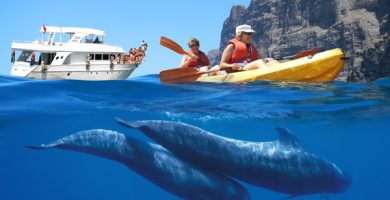
Kayaking and Whale and Dolphin Watching in Los Gigantes
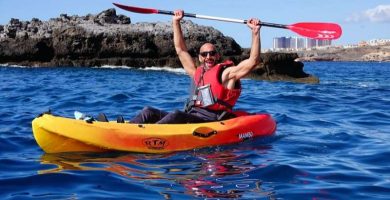
Kayak rental in La Caleta, Adeje

Paragliding in Tenerife

Karting Tenerife
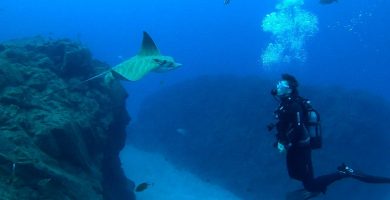
Try Dive in Tenerife south – The best place to dive for beginners
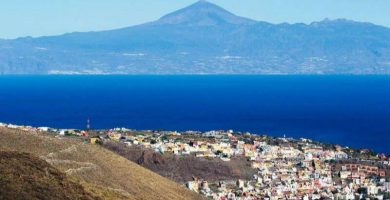
Trip Tenerife – La Gomera: discover the island in one day excursion

Stargazing on Mount Teide – The best excursions and experiences
